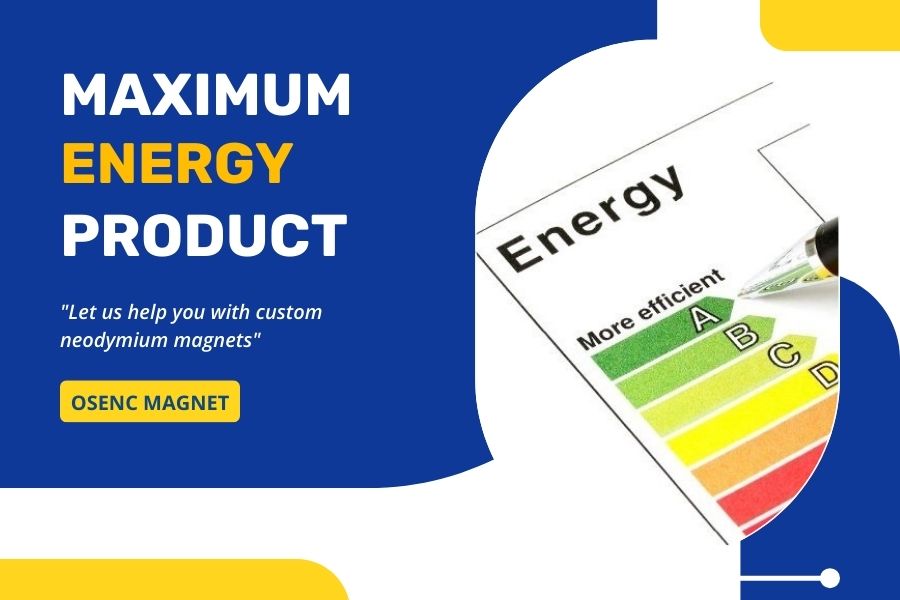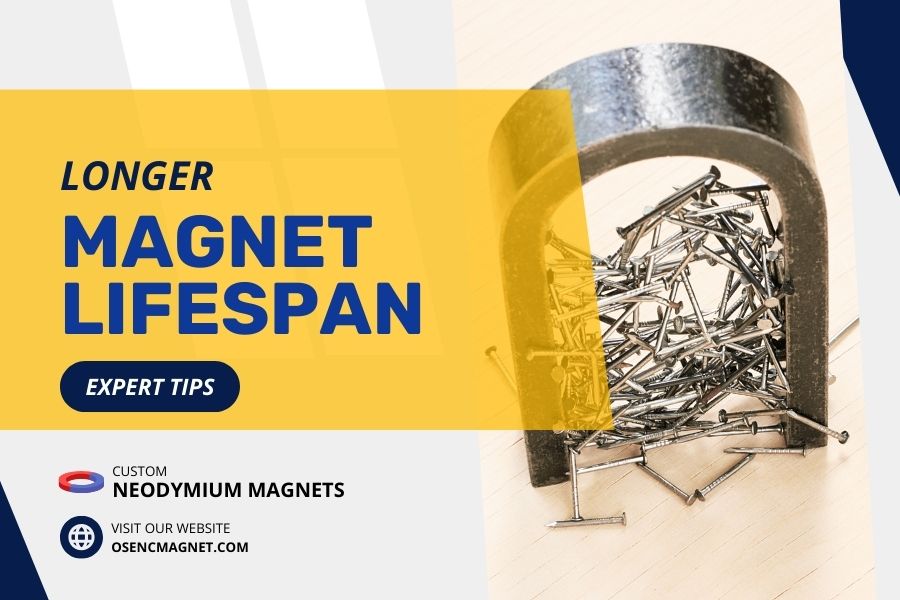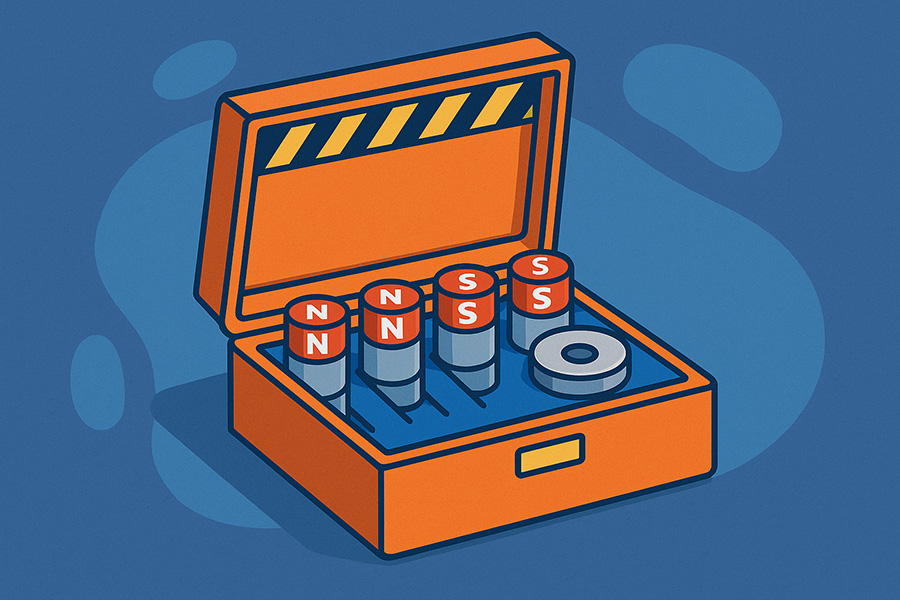You might have heard of maximum energy product, or (BH)max, if you’re interested in magnets.
It’s a crucial property.
It tells us a lot about a magnet’s strength and performance.
In this post, we’ll dive into what maximum energy product is.
We’ll explore why it matters.
And we’ll look at how it impacts real-world applications.
Let’s get started!
Table of Contents
What Is Maximum Energy Product?
Shopping for magnets? You’ll see “(BH)max” or “maximum energy product” a lot. It’s like a power rating for your magnet.
This number shows how much magnetic energy a magnet stores in its volume. Higher numbers mean stronger magnets for their size. This matters when you need small but powerful magnets.
The maximum energy product is built into the magnetic material itself. A tiny N52 neodymium magnet has the same BHmax as a large N52 magnet. The bigger one just has more total energy because of its size.
In real terms, maximum energy product measures the magnetic “snap” or “push” a magnet delivers in an air gap, per volume. It’s how much magnetic energy transfers to a magnetic circuit.
Breaking Down the Science (Simply)
Maximum energy product comes from two magnetic properties working together:
Magnetic Flux Density (B)
This measures field strength in teslas (T) or gauss. Neodymium magnets typically range from 1.17-1.48 tesla, depending on grade.
Magnetic Field Strength (H)
This shows how well a magnet resists demagnetization, measured in amperes per meter (A/m) or oersteds. Quality neodymium magnets have coercive force (Hc) greater than 11.0 kOe.
When you multiply B × H at different points on a magnet’s performance curve, one point gives the highest product. That’s the maximum energy product.
Think of it like this: plot B on the vertical axis and H on the horizontal axis. You’ll get a demagnetization curve. The maximum energy product is the largest rectangle you can fit under this curve in the second quadrant. This rectangle shows the magnet’s maximum energy density.
Why Maximum Energy Product Matters to Buyers
Understanding maximum energy product helps you buy smarter. Here’s why it matters:
- Get the right size: Higher (BH)max means smaller magnets do the same job. This is why people call neodymium magnets “stronger” – more magnetic “snap” per volume.
- Save money: A small, high-grade magnet might cost less than a large, low-grade one. Higher grades cost more per volume, but you need less material.
- Cut weight: This matters when every gram counts, like in electronics or aerospace.
- Know what you’re getting: Understand the exact strength before buying, so you can make precise design calculations.
- Create stronger fields: Higher BHmax magnets produce stronger fields on their surfaces and in air gaps. Two same-sized magnets with different grades will have noticeably different pull forces.
Understanding Units: MGOe and kJ/m³
Maximum energy product comes in two main units:
- MGOe (Mega Gauss Oersteds): The industry standard that suppliers and manufacturers use
- kJ/m³ (kilojoules per cubic meter): The scientific unit used in academic and engineering work
Need to convert?
- Multiply MGOe by 7.96 to get kJ/m³.
A N52 magnet with 52 MGOe has about 414 kJ/m³ energy product.
Comparing Different Magnet Materials
Different magnets have different energy products:
Neodymium (NdFeB) Magnets
- Today’s strongest commercial magnets
- Energy products from 33-55 MGOe based on grade
- Best when you need top strength in small spaces
- Now used in most high-performance applications
Samarium Cobalt (SmCo) Magnets
- Energy products usually 20-30 MGOe
- Great for high heat (up to 350°C)
- Resist corrosion without coatings
- Cost more than neodymium but vital for high-temp uses
Ceramic (Ferrite) Magnets
- Energy products about 3-5 MGOe
- Much cheaper than rare earth options
- Good for basic, budget-friendly uses
- Need about 10 times more volume than neodymium for the same strength
AlNiCo Magnets
- Energy products around 5-9 MGOe
- Very stable at different temperatures
- Useful for specific applications
- Common before rare-earth magnets came along
Real-World Applications of Neodymium Magnets
Here’s how maximum energy product works in real applications:
Electric Motors & Generators
- Used in brushless DC motors, servo motors, and generators
- High energy product creates more torque and power density
- Motors often need higher-temp grades (SH, AH) due to coil heat
- A Toyota Prius uses about 1 kg of neodymium magnets in each motor
- Shape matters – rings or arc segments fit rotors best
- High BHmax means smaller, lighter motors with better torque
Sensors and Switches
- Small neodymium magnets trigger reed switches, Hall sensors, and encoders
- Even N35-N42 grades work well in small sizes
- These uses need stable, consistent fields
- Coatings protect against wear and moisture
- According to K&J Magnetics, tiny rare earth magnets often activate sensors and relays
- These can be extremely small yet still work reliably
Holding, Lifting, and Fixtures
- Found in magnetic hooks, latches, and tool holders
- Higher grades (N42-N52) hold things better
- Larger cross-section (blocks or discs) increases pull force
- Shape affects performance: cylinders or rings focus flux where needed
- For holding things, bigger area plus high BHmax equals stronger grip
- Hard drives and tool holders typically use N42-N52 grades
Crafts, DIY, and Novelty Uses
- Common in jewelry clasps, fridge magnets, and toys
- Craft magnets often use N35-N42 (strong enough but cheaper)
- Usually coated with nickel, epoxy, or gold for looks and safety
- Sphere magnets concentrate field at their poles, creating strong points
- Crafts need good looks and ease of use – coatings help with both
- Disc magnets on decorative items make great fridge magnets
- Magnetic balls sold as toys (now regulated in some markets)
Neodymium Magnet Grades and Their Properties
Neodymium magnets come in grades that show their energy product.
Look for codes like N35, N42, N48, and N52.
The number after “N” roughly matches the maximum energy product in MGOe.
Quick guide to common grades:
- N35: 33-35 MGOe, flux density of 1.17-1.21 tesla
- N38: 36-38 MGOe, flux density of 1.22-1.26 tesla
- N42: 40-42 MGOe, flux density of 1.30-1.32 tesla
- N45: 43-45 MGOe, flux density of 1.33-1.37 tesla
- N48: 45-48 MGOe, flux density of 1.38-1.42 tesla
- N52: 49.5-52 MGOe, flux density of 1.45-1.48 tesla
Higher grades create stronger fields but cost more because they contain more neodymium and dysprosium.
Choose the grade that fits your needs.
When you see “N42SH,” the “N42” shows the energy product (about 42 MGOe), while “SH” shows it works in temperatures up to 150°C.
Factors That Affect Maximum Energy Product
Several things influence a magnet’s energy product:
Temperature
Heat weakens magnets. Standard neodymium magnets (N grade) work up to about 80°C before losing strength permanently.
For hotter applications, special grades exist:
- M grade: Works up to ~100°C
- H grade: Works up to ~120°C
- SH grade: Works up to ~150°C
- UH grade: Works up to ~180°C
- EH grade: Works up to ~200°C
- AH grade: Works up to ~220°C
For example, an “N42SH” magnet has about 42 MGOe energy product and handles temperatures up to 150°C.
Manufacturing Process
How a magnet is made matters. Sintered magnets are stronger than bonded ones. Sintering aligns magnetic domains better, creating stronger magnets.
Material Grade
Different grades of the same material have different energy products. Higher grades cost more but perform better. The amount of neodymium and dysprosium in the alloy affects the energy product.
Domain Alignment
Magnets magnetized in specific directions (anisotropic) outperform those magnetized randomly (isotropic). During production, external fields align the domains for best results.
Coating and Corrosion Protection
While coatings don’t directly affect energy product, they’re vital since neodymium magnets corrode easily.
Common coatings include:
- Nickel-Copper-Nickel: Standard triple-layer with 24+ hours of salt-spray resistance, typically 15-21 µm thick
- Zinc: Alternative metal coating
Epoxy: Thicker coating with better corrosion resistance (48-72 hours in salt-spray tests) - Gold: Premium coating with excellent corrosion resistance and good looks
Mechanical Considerations
Neodymium magnets are brittle and can chip if dropped. Manufacturing tolerances are typically ±0.05 mm on small dimensions and ±0.1 mm on larger ones. For precision uses like motors or sensors, these tolerances can be critical.
Magnet Shapes and How They Affect Field Patterns
A magnet’s shape changes its field pattern and performance.
Here’s how different shapes work:
Disc (Cylindrical) Magnets
- Usually magnetized with north on one flat face, south on the other
- Create strong, even fields straight out from the faces
- Easy to stack or mount on flat surfaces
- Popular in crafts, sensors, and holders
- Small thin discs work well in crafts; large ones (half-inch+) have high pull force
Block (Rectangular) Magnets
- Typically magnetized through thickness (one broad face north, opposite face south)
- Give strong, uniform fields across those faces
- Versatile for machinery or mounting
- Can be cut smaller if needed (by professionals)
- Cutting concentrates the field but reduces total area
Ring (Tube) Magnets
- Discs with holes in the middle
- Can be magnetized along the axis (faces are N/S) or radially (inner edge N, outer S, or reversed)
- The hole changes the field, with more flux from the outer edge
- Creates longer-range fields than solid discs
- Great for mounting on shafts, in encoders, or speaker motors
- Axial rings have poles on the flat faces
- Radial rings have north on the outer surface and south on the inner bore (or reversed)
Spherical (Ball) Magnets
- Magnetized along a diameter (north at one point, south opposite)
- Field emerges symmetrically from the two pole points
- Higher field concentration at poles than blocks or discs
- Each ball has two tiny pole points that strongly attract other magnets
- Can roll to find magnetic alignment
- Used in toys, crafts, and education
Specialty Shapes
- Countersunk blocks (with screw holes)
- Stepped magnets (with different diameters)
- Arc/segment magnets (pie pieces for motors)
- Custom shapes for specific uses
The shape controls where poles are and how the field spreads.
Choose based on your mechanical needs and desired field pattern.
Practical Example: Choosing the Right Magnet
Let’s say you need a magnet for a small sensor:
- Using ferrite magnets (3-5 MGOe), you’d need something fairly large to get enough field strength.
- With a neodymium magnet (up to 55 MGOe), you could use something tiny—maybe 10 times smaller.
This matters when space or weight is limited.
A small N42 disc might trigger a reed switch just as well as a much bigger ceramic magnet, while taking up way less space in your design.
Making Your Selection
When choosing magnets based on energy product:
- Figure out the minimum strength your application needs.
- Think about space limits and what shape works best.
- Consider environment factors like heat and moisture.
- Pick the right coating for your conditions.
- Check mechanical tolerances (usually ±0.05 mm on small parts, ±0.1 mm on larger ones).
- Balance performance against what you can spend.
You don’t always need the highest (BH)max.
Often, a lower-grade magnet works fine for less money.
- For hobby projects, N35-N42 grades usually offer enough strength while costing less than N52.
When designing applications, match the shape and magnetization to your needs:
- Motors need high flux for torque, but magnets must handle coil heat too.
- Sensors need small size and consistent field more than maximum force.
- Holding applications need good contact area as much as high BHmax.
- Precision assemblies need suppliers who can meet your tolerance requirements.
Ready to Choose Your Magnet?
Now you understand maximum energy product and how it affects magnet performance.
Still not sure which magnet is right for you?
Contact us for expert advice tailored to your specific needs.
With the right magnet, your project will work better, cost less, and last longer.



